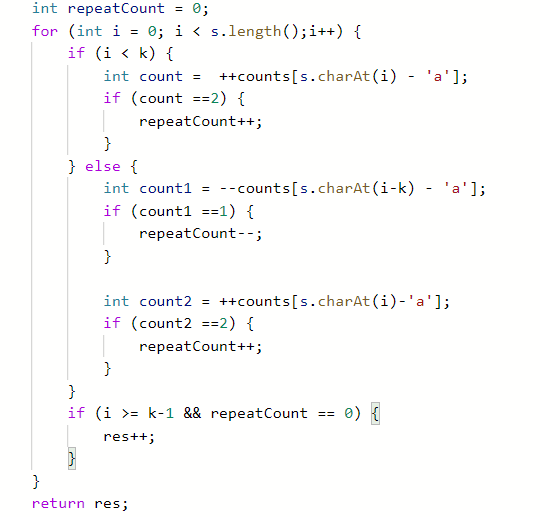22年8月刷题日记(0730-0817)#
[toc]
2022-07-30#
简单,题意理解了就好, 排列组合的数学应用
简单,推导出贪心规律,从左到右只要符合平衡,就一定可以从更大的平衡串中拆掉
“111011011”这种二进制字符串如何快速转int整数?
可以用
1 | Integer.parseInt("111011011", 2) |
2指代二进制
2022-07-29#
如何用4个点判断是否是一个正方形?
-
方法1: 设置顺时针点为1->2->3->4,然后根据边长相同、22边平行、勾股定理3者判断是否为正方形。
1->2->3->4点的判定先根据横坐标最小,再根据纵坐标最小。
-
方法二:正方形的任意3个点都是等边直角三角形,判断4次即可,注意额外加一个三角形中边的判断
1 | long len = -1; |
1642. 可以到达的最远建筑 - 力扣(LeetCode)
简单贪心题。
注意PriorityQueue默认小顶堆
1285. 找到连续区间的开始和结束数字 - 力扣(LeetCode)
-
row_number() over() 指每一行在整个表分区中的序号
-
over()是窗口函数,不会做汇聚动作,因此行数不会发生变化。只会给出每一行所处分区的某个特定值(例如各分区的和 sum over(PARTITION by xxx))
-
id - row_number() over() diff 外层套一个group by diff可以用来求解连续区间的问题
2022-08-01#
剑指 Offer II 082. 含有重复元素集合的组合 - 力扣(LeetCode)
- dfs全排列搜索问题且要求不能重复,关键语句就是”预处理排序。选的时候前一位相同,则必须是连续选的情况,不可以前面的相同数字还没选,却选了自己“
1 | if (i-1 >= 0 && nums[i-1] == nums[i] && lastIndex != i-1) { |
- list.remove(int) 就是按索引移除。 list.remove(object)是针对非int对象的
-
写了4个2重循环好麻烦,就是提前预处理好每个点的上下左右到最近0的距离即可
-
for (int y = 0, dis=0; y < n;y++) 此时int等同于声明了dis,外层不可再声明dis了
2022-08-03#
2265. 统计值等于子树平均值的节点数 - 力扣(LeetCode)
直接后序遍历即可
翻转问题还是写一个reverse的简单方法会比较快,用stringBuilder不一定快
1 | void reverse(char[] cs, int left, int right); |
集合应用,没啥好说的
2022-08-04#
1403. 非递增顺序的最小子序列 - 力扣(LeetCode)
排序即可
将出点和入点放入数组中,出点位置+seats, 入点位置-seats即可
1115. 交替打印 FooBar - 力扣(LeetCode)
第一次做多线程的题目,还蛮有意思的
要求交替打印n次foo和bat
其实可以用资源的角度来理解
即需要打印foo时,说明生产了一个foo令牌,才可以打印
如果要打印bar,则要求有bar令牌才可以。
那么就很容易想到用2个阻塞队列或者2个信号量
1 | class FooBar { |
当然也可以用一个boolean布尔值来表示此时打印foo还是打印bar,然后利用等待-唤醒机制。
如果用java自带语法,可以是wait和notify。
1 | class FooBar { |
如果使用JUC,则用Condition即可。
1 | class FooBar { |
2022-08-05#
1055. 形成字符串的最短路径 - 力扣(LeetCode)
2个字符串长度最多1000,双指针即可,没啥难的
剑指 Offer II 092. 翻转字符 - 力扣(LeetCode)
提前预处理往左看的1的个数和往右看的0的个数
然后再遍历一次,每次把左边翻0,右边翻1,因为预处理过了所以可以马上得到答案
但是这个做法比较消耗2个O(n)的空间
用动态规划可以节省很多空间
1 | public int minFlipsMonoIncr(String s) { |
就是数量统计题而已
2022-08-07#
栈的应用题,start和end等同于左括号和右括号
注意用int[]数组来简化新类的定义操作,注意每次end出栈后,要把这段程序占用的总时间加到栈顶
2022-08-08#
提示dfs最大深度为25,则认为可以直接做带vis访问标记的dfs且不需要做记忆化结果。
另外dfs时也不要忘记对初始点的vis处理
1365. 有多少小于当前数字的数字 - 力扣(LeetCode)
虽然是简单题,数量级别只有500,但还是考虑写了一下最快性能,直接按值做键处理,就能知道比每个值小的数量了,然后再分别设置。
这题没做出来,直接看答案了
0和1的数量相等 + 任意前缀1数量大于0, 类似于括号匹配
要我们调整括号对使得字典序尽可能大
这样就很容易想到递归了,即最外层括号可以不管, 然后只对内层做处理, 内层找到每一个括号对,然后按字典序排序。
-
字符串list快速拼接:list.stream().collect(Collectors.joining());
-
s.subString(a,b)中b是开区间
2022-08-09#
1413. 逐步求和得到正数的最小值 - 力扣(LeetCode)
遍历求和,求中间sum距离1的最大差值即可
O(二叉树节点*链表节点)的复杂度符合要求
遍历每个点为起点,然后往下搜索判断能否找到即可,还是挺有意思的递归应用
1 | public boolean isSubPath(ListNode head, TreeNode root) { |
剑指 Offer II 077. 链表排序 - 力扣(LeetCode)
要求在 O(n log n) 时间复杂度和常数级空间复杂度下,对链表进行排序
那所有排序方法里,只有递归排序可以实现了
而且得是从下往上递归
先11合并,再22合并,再44合并。
链表归并排序处理的几个坑:
- 头节点可能变更的话,最好提前创建一个dummy头节点,这样dummy头节点.next就是新节点了
- 注意记录下一个排序序列的起始节点,用于确认是否第二个序列到末尾结束了。
- 还要记录上次排序序列的末尾节点, 用于排序后更新 上次末尾节点.next
1 | class Solution { |
2022-08-10#
1253. 重构 2 行二进制矩阵 - 力扣(LeetCode)
还是蛮容易推导的一个数组题,先处理掉所有0和2的情况
再处理1的情况,先把1都分配给上边,上边不够之后再分配给下边,最后检查是否清零即可。
很有意思的搜索题,我想到了bfs,且这个bfs是支持刷新点的bfs。先优先按最大的走
如果发现当前点被人走过,但是自己是比他优(不能相等),则可以刷新对方自己继续走。
1 | // 已经有人走过,且自己不能刷新最好记录,则没必要走了,别人已经在走了 |
当然看答案还有dfs+二分, 即确定目标最小值之后, dfs搜索最多10000次。
复杂度O(10000 * (log2(10^9)))
剑指 Offer II 024. 反转链表 - 力扣(LeetCode)
用递归做比较有趣
2022-08-11#
直接递归判断,简单
面试题 10.05. 稀疏数组搜索 - 力扣(LeetCode)
二分搜索,但我还是遍历了一遍先过滤空字符串了。导致性能是1ms
但差距不大是因为那些人也要定位后在0上去走,消耗不会差别太大。
1100. 长度为 K 的无重复字符子串 - 力扣(LeetCode)
很简单的滑动窗口
- 第一波做出来性能20ms,不是最佳。因为用了Stream去判断是否有重复
1 | public boolean valid(int[] counts) { |
-
去掉Stream改用简单for循环,性能就到 5 ms 了
-
去掉k>26的判断,提升到4ms
-
避免每次26次判断,用repeatCount值来记录,这样每次最多判断2次,结果还是4ms

一般那种要你交叉放数字的,都可能有一种改进点是看你能否空间复杂度为O(1)(不包含结果输出空间)
这就需要原地算法,双指针进行交换
2022-08-12#
按数量建哈希表,每个数量对应一个列表,列表满了就放入结果中并重置,很简单
只能取左右两边,那么等同于滑动窗口,只不过是反着求中间的滑动窗口最小值
剑指 Offer II 067. 最大的异或 - 力扣(LeetCode)
很有意思,要求 nums[i] XOR nums[j] 的最大运算 结果
想了半天终于想起来有一个字典树这玩意,一开始觉得麻烦,后来还是写了 ,答案也有这个思路,很棒
只不过自己得记住,要先在字典树中试图求解最大运算结果, 求解完成后,才能把自己再插入字典树中
2022-08-13#
1678. 设计 Goal 解析器 - 力扣(LeetCode)
直接取临时字符串然后判断即可
1874. 两个数组的最小乘积和 - 力扣(LeetCode)
直接排序后第一个数组的最大乘第二个数组的最小,依次处理即可,很简单,虽然我不知道怎么证明 768. 最多能完成排序的块 II - 力扣(LeetCode)
一次就AC了, 想到了动态规划
每次求出左边的最大值
然后看一下自己当前位置往左边遍历时,选取那个左边位置作为一块,能否满足要求,能满足要求则就看判断当前最大分割块即可
1 | if (左边最大值 小于 我当前位置从右往左遍历时的最小值, 说明可以分割){ |
2022-08-15#
循环双端队列,其实关键在于循环队列的定义,双端的话很容易处理的。
这题肯定是要用数组来做比较有意义
循环队列数组概念硬记忆:
- front指向已存储的队头元素, rear指向已存储的队尾元素的下一个位置(即空位置)
- 队满: (Q.rear+1)%M = Q.front, 即队尾的下一个位置已经有了
- 队空: Q.front = Q.rear 即队头存储的是一个空的
- 队长: (rear-front+M)%M
剑指 Offer 66. 构建乘积数组 - 力扣(LeetCode)
很简单, 直接计算左边前缀乘积, 计算右边前缀乘积即可
1015. 可被 K 整除的最小整数 - 力扣(LeetCode)
-
数字末尾是1的情况下,肯定不能被2和5整除
-
通过公式推导:
1
2
3
4
5
6
7
8
9设n=p*K+q
则n*10+1= 10*p*K + q*10+1;
对两边都取k取余
有(n*10+1)%K=(10*p*K+q*10+1)%K
又因为n%k=q
则右边(10*p*K+q*10+1)%K = (q*10+1)%K = (n%k*10 + 1) %K
推断出:(n*10+1)%K = ((n%K)*10+1)%K
因此(n*10+1)如果能被k整除,等同于 (n%k)*10+1被k整除
所以只要n做增加时先取余即可
不含2和5的质因子的数必定在K之内有解,直接用其mod循环即可,避免了大数之间的除法
2022-08-16#
用String[]做数组,当前点之前是空,现在要插入,则可以尝试往后遍历直到遇到空
2278. 字母在字符串中的百分比 - 力扣(LeetCode)
没看懂有啥用
直接按3取余,不断除3,直到为1说明就是3的幂
题解有个超简单方法:
根据数值范围,找到最大的3幂的值 1162261467 ,然后直接看 1162261467 能否被询问的这个值整除即可
这提示我们如果以后遇到这种需求,可以直接定义一个最大范围值取判断,而不用自己重复去循环计算
1 | class Solution { |
2022-08-17#
记住gcd公式:
1 | public int gcd(int x, int y) { |
或者这题里因为题目必须要求分成每组X个,所以总数必须要能被X整除,这就过滤掉很多了
一个树,加上一个边构成带环的图,问怎么找到应该去掉的那条边,重新变回树
我最初的思路:每次去掉一个边,然后做bfs看是否重新碰到自己的点,但是要考虑很多判断,很麻烦
这题最佳是用并查集, 当拼接的时候,如果发现左右两个点属于同一个集合,则一定会出现环
即是否图中成环的判断可以用这个方式:
通过边连接2个点的时候,如果2个点属于同一个并查集,则一定存在环
1733. 需要教语言的最少人数 - 力扣(LeetCode)
最开始以为我的思路需要500乘500乘500
后来发现其实好友关系的总数只有500,即边只有500个
则遍历次数少了500倍
那可以直接遍历每种语言,判断能否加
注意需要提前处理掉那些不需要新学语言的人(即他和他的所有好友都有共同语言)